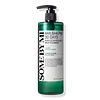What's inside
What's inside
 Key Ingredients
Key Ingredients

 Benefits
Benefits

 Concerns
Concerns

 Ingredients Side-by-side
Ingredients Side-by-side

Salicylic Acid 3%
MaskingWater
Skin ConditioningAmmonium Lauryl Sulfate
CleansingSodium Laureth Sulfate
CleansingSodium Citrate
BufferingCocamidopropyl Betaine
CleansingLauryl Glucoside
CleansingPEG-150 Pentaerythrityl Tetrastearate
EmulsifyingCoco-Glucoside
CleansingGlyceryl Oleate
EmollientAleurites Moluccanus Seed Oil
Skin ConditioningZinc PCA
HumectantRheum Palmatum Root/Stalk Extract
AstringentCarthamus Tinctorius Flower Extract
Skin ConditioningCamellia Sinensis Leaf Extract
AntimicrobialPanthenol
Skin ConditioningDisodium EDTA
Salicylic Acid 3%, Water, Ammonium Lauryl Sulfate, Sodium Laureth Sulfate, Sodium Citrate, Cocamidopropyl Betaine, Lauryl Glucoside, PEG-150 Pentaerythrityl Tetrastearate, Coco-Glucoside, Glyceryl Oleate, Aleurites Moluccanus Seed Oil, Zinc PCA, Rheum Palmatum Root/Stalk Extract, Carthamus Tinctorius Flower Extract, Camellia Sinensis Leaf Extract, Panthenol, Disodium EDTA
Water
Skin ConditioningLauric Acid
CleansingGlycerin
HumectantPotassium Hydroxide
BufferingMyristic Acid
CleansingSodium Chloride
MaskingSodium C14-16 Olefin Sulfonate
CleansingLauryl Hydroxysultaine
CleansingBenzyl Glycol
SolventCoco-Betaine
CleansingSalicylic Acid
MaskingEucalyptus Globulus Leaf Oil
PerfumingButylene Glycol
HumectantEthylhexylglycerin
Skin ConditioningMelia Azadirachta Leaf Extract
Skin ConditioningDisodium EDTA
Coptis Japonica Root Extract
Skin Conditioning1,2-Hexanediol
Skin ConditioningMelia Azadirachta Flower Extract
Skin ConditioningMelaleuca Alternifolia Leaf Water
AntimicrobialEthyl Hexanediol
SolventCentella Asiatica Extract
CleansingAsiaticoside
AntioxidantMadecassic Acid
Skin ConditioningGluconolactone
Skin ConditioningCitric Acid
BufferingAsiatic Acid
Skin ConditioningMandelic Acid
AntimicrobialMadecassoside
AntioxidantArtemisia Vulgaris Extract
Skin ConditioningWater, Lauric Acid, Glycerin, Potassium Hydroxide, Myristic Acid, Sodium Chloride, Sodium C14-16 Olefin Sulfonate, Lauryl Hydroxysultaine, Benzyl Glycol, Coco-Betaine, Salicylic Acid, Eucalyptus Globulus Leaf Oil, Butylene Glycol, Ethylhexylglycerin, Melia Azadirachta Leaf Extract, Disodium EDTA, Coptis Japonica Root Extract, 1,2-Hexanediol, Melia Azadirachta Flower Extract, Melaleuca Alternifolia Leaf Water, Ethyl Hexanediol, Centella Asiatica Extract, Asiaticoside, Madecassic Acid, Gluconolactone, Citric Acid, Asiatic Acid, Mandelic Acid, Madecassoside, Artemisia Vulgaris Extract
 Reviews
Reviews

Alternatives
Ingredients Explained
These ingredients are found in both products.
Ingredients higher up in an ingredient list are typically present in a larger amount.
Disodium EDTA plays a role in making products more stable by aiding other preservatives.
It is a chelating agent, meaning it neutralizes metal ions that may be found in a product.
Disodium EDTA is a salt of edetic acid and is found to be safe in cosmetic ingredients.
Learn more about Disodium EDTASalicylic Acid (also known as beta hydroxy acid or BHA) is a well-known ingredient for treating skin that struggles with acne and clogged pores. It exfoliates both the skin's surface and deep within the pores to help clear out buildup, control oil, and reduce inflammation.
Unlike AHAs (alpha hydroxy acids), salicylic acid is oil-soluble. This allows it to penetrate into pores which makes it especially effective for treating blackheads and preventing future breakouts.
Salicylic acid is also known for its soothing properties. It has a similar structure to aspirin and can calm inflamed or irritated skin, making it a good option for acne-prone skin that is also sensitive.
Concentrations of 0.5-2% are recognized by the U.S. FDA as an over-the-counter topical acne product.
It can cause irritation and/or dryness if one's skin already has a compromised moisture barrier, so it's best to focus on repairing that before introducing this ingredient into your routine.
While salicylic acid does not increase sun sensitivity, it’s still important to wear sunscreen daily to protect your skin.
If you are looking for the ingredient called BHA or Butylated Hydroxyanisole, click here.
Learn more about Salicylic AcidWater. It's the most common cosmetic ingredient of all. You'll usually see it at the top of ingredient lists, meaning that it makes up the largest part of the product.
So why is it so popular? Water most often acts as a solvent - this means that it helps dissolve other ingredients into the formulation.
You'll also recognize water as that liquid we all need to stay alive. If you see this, drink a glass of water. Stay hydrated!
Learn more about Water